Practicing the CBSE Sample Papers for Class 12 Chemistry with Solutions Set 7 allows you to get rid of exam fear and be confident to appear for the exam.
CBSE Sample Papers for Class 12 Chemistry Set 7 with Solutions
Time : 3 Hours
Maximum Marks: 70
General Instructions :
Read the following instructions carefully.
- There are 35 questions in this question paper with internal choice.
- SECTION A consists of 18 multiple-choice questions carrying 1 mark each.
- SECTION B consists of 7 very short answer questions carrying 2 marks each.
- SECTION C consists of 5 short answer questions carrying 3 marks each.
- SECTION D consists of 2 case-based questions carrying 4 marks each.
- SECTION E consists of 3 long answer questions carrying 5 marks each.
- All questions are compulsory.
- Use of log tables and calculators is not allowed
Section – A
The following questions are multiple-choice questions with one correct answer. Each question carries 1 mark. There is no internal choice in this section.
Question 1.
The standard emf of a galvanic cell involving cell reaction with n = 2 is formed to be 0.295 V at 25° C. The equilibrium constant of the reaction would be: [1]
(a) 1.0 × 1010
(b) 2.0 × 1011
(c) 4.0 × 1012
(d) 1.0 × 102
[Given F = 96500 (mol-1); R = 8.314 JK-1 mol-1]
Answer:
(a) 1.0 × 1010
Explanation: Given Data: 1 α F = 96500 C mol-1
2 α R = 8.314 JK-1 mol-1
3 α T = 25°C = 25 + 273 = 298 K
4 α E°cell = 0.295 V
To Find: Equilibrium constant = ?
By Nems’t equation, Ecell = E°celI – \(\frac{2.303 \mathrm{RT}}{n \mathrm{~F}}\) log10K
At equilibrium, Ecell = 0
∴ E°cell = \(\frac{2.303 \times 8.314 \times 298}{2 \times 96500}\) log10K
= \(\frac{0.0591}{2}\) log10K
∴ 0.295 = \(\frac{0.0591}{2}\) log10K
log10K = \(\frac{0.295 \times 2}{0.0591} \) = 10
antilog (log10K) = antilog 10 (Taking antilog on both side)
K = 1.0 x 1010
Question 2.
The Van’t Hoff factor accounts for: [1]
(a) Degree of solubilisation of solute.
(b) The extent of dissociation of solute.
(c) The extent of dissolution of solute.
(d) The degree of decomposition of solution.
Answer:
(b) The extent of dissociation of solute.
Explanation:
The Vant’t Hoff’s Y accounts for the extent of dissociation of solute.
For example, one molecule of NaCl completely dissociates to produce two ions.
NaCl → Na+ + Cb–
Hence, its Vant’t Hoff’s factor ‘i’ is 2.
![]()
Question 3.
Which of the following is not a neutral ligand? [1]
(a) H2O
(b) NH3
(c) ONO
(d) CO2
Answer:
(c) ONO
Explanation: Neutral ligands are those ligands that do not have any charge over them.
Example: H2O, NH3, CO, C2H4. ONO– has charge on it, therefore, it is not neutral ligand.
Question 4.
In the reaction of phenol with CHC13 and aqueous NaOH at 70°C, the electrophile attacking the ring is: [1]
(a) CHCl3
(b) CHCl2
(C) CCl2
(d) COCl2
Answer:
(c) CCl2
Explanation: In the reaction of phenol with CHCl3 and aq NaOH at 343K, the electrophile attacking the ring is CCl2 (Reimer Tiemann Reaction and Carbene formation).

Question 5.
The action of sodium on alkyl halide to form an alkane is called : [1]
(a) Grignard reaction
(b) Wurtz coupling reaction
(c) Isocyanide reaction
(b) Wurtz coupling reaction
(d) Halogenation reaction
Answer:
(b) Wurtz coupling reaction
Explanation: Wurtz-reaction is a coupling reaction in organic chemistry, where two alkyl halides react with sodium metal in dry ether solution to form a higher alkane.
Question 6.
All galvanic cells do not contain: [1]
(a) A cathode
(b) an anode
(c) ions
(d) a porous plate
Answer:
(d) a porous plate
Explanation: All galvanic cells do not contain a porous plate.
Question 7.
Maltose on hydrolysis gives: [1]
(a) α – D – glucose
(b) α and β – D – glucose
(c) Glucose and fructose
(d) Fructose only
Answer:
(a) α-D-glucose
Explanation: Maltose is also known as malt sugar. It is a disaccharide, made up of two D-glucose units. The two units of glucose are linked with an alpha 1,4 glycosidic bond. Thus, maltose on hydrolysis gives 2 moles of α-D-glucose.

Question 8.
In KMnO4, oxidation number of Mn is: [1]
(a) + 2
(b) + 4
(c) + 6
(d) + 7
Answer:
(d) + 7
Explanation: Let Mn be x
⇒ 1 + x + (-2) × 4 = 0
= 1 + x – 8 = 0
= x – 7 = 0
⇒ x = + 7
∴ oxidation state of Mn is + 7
Hence, the oxidation number of Mn in KMnO4 is + 7.
Question 9.
Identify ‘X’ in the reaction given below: [1]

(a) CrO3
(b) CrO2Cl2
(c) Alkaline KMnO4
(d) Anhydrous AlCl3
Answer:
(b) CrO2Cl2
Explanation: This is known as Etard reaction. The chromyl chloride oxidises the methyl group to a chromium complex in CS2. This complex on hydrolysis gives benzaldehyde. For the given reaction, when toluene is treated with chromyl chloride in CS2, brown chromium complex is formed, which on hydrolysis gives benzaldehyde.

Question 10.
In the hydroboration-oxidation reaction of propene with diborane, H2O2 and NaOH, the organic compound formed is: [1]
(a) CH3CH2OH
(b) CH3CH(OH)CH3
(C) CH3CH2CH2OH
(d) (CH3)3COH
Answer:
(C) CH3CH2CH2OH
Explanation: The hydroboration oxidation reaction converts an alkene into neutral alcohol by the addition of water across the double bond. The hydrogen and hydroxyl groups are added in a syn addition leading to cis stereochemistry. Hydroboration oxidation is an anti-markovnikov reaction, with the hydroxyl group attaching to the less-substituted carbon. In the hydroboration – oxidation reaction of propene the organic compound formed is CH3CH2CH2OH.

Question 11.
The linkage which holds various amino acid units in primary structures of proteins is : [1]
(a) Glycoside linkage
(b) Peptide linkage
(c) Ionic linkage
(d) Hydrogen bond
Answer:
(b) Peptide linkage
Explanation: Peptide linkage is also known as peptide bond. It is an amide formed between – COOH and -NH2 group by elimination of a water molecule.
![]()
Question 12.
Benzoyl Chloride on reduction with H2/Pd-BaSO4 produces: [1]
(a) Benzoic acid
(b) Benzyl alochol
(c) Benzoyl sulphate
(d) Benzaldehyde
Answer:
(d) Benzaldehyde (Aldehyde, Ketone and carboxylic acid)
Explanation: A Rosenmund catalyst is used to reduce acyl chlorides to their corresponding aldehydes and is typically composed of palladium supported on BaSO4.
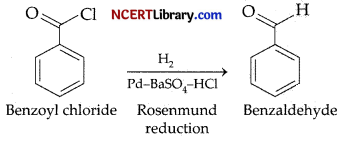
Question 13.
The half-life of the first order reaction having rate constant k = 1.7 × 10-5s-1 is: [1]
(a) 12.1 h
(b) 9.7 h
(c) 11.3 h
(d) 1.8 h
Answer:
(c) 11.3 h
Explanation: \( t_{1 / 2}\) = \( \frac{\ln 2}{k}\) = \( \frac{0.693}{1.7 \times 10^{-5}}\) = 40764 sec = \(\frac{40764}{3600}\) hrs = 11.3 hrs.
Question 14.
According to Werner’s theory of coordination compounds: [1]
(a) Primary valency is ionisable
(b) Secondary valency is ionisable
(c) Primary and secondary valencies are ionisable
(d) Neither primary nor secondary valency is ionisable
Answer:
(a) Primary valency is ionisable
Explanation: Metals possess two types of valencies: primary (principal) or ionisable valency and secondary or non-ionisable valency.
Primary valencies are those which a metal usually exhibits in the formation of its simple salts. Thus, in the formation of PtCl4, CuSO4, and AgCl. The primary valencies of Pt, Cu, and Ag are 4, 2 and 1, respectively. Primary valencies are satisfied by negative ions.
Secondary valencies are those which a metal cation exercises towards a neutral molecule or negative group in forming its complex ions. Thus, secondary valencies may be satisfied by negative ions, neutral molecules having lone electron pair (Example: H2O, NH3, etc.) or even sometimes by some positive groups.
Question Number 15 to 18 consist of two statements – Assertion (A) and Reason (R). Answer these questions selecting the appropriate option given below:
(a) Both A and R are true and R is the correct explanation of A.
(b) Both A and R are true but R is not the correct explanation of A.
(c) A is true, but R is false.
(d) A is false, but R is true.
Question 15.
Assertion (A): During reduction of nitrobenzene, Fe + HCl is preferred as the reagent. [1]
Reason (R): During oxidation of nitroalkanes into alkanamines the preferred reagent is Fe + HCl.
Answer:
(c) A is true, but R is false
Explanation: During the reduction of a nitro alkane, iron scrap (Fe) + HCl is preferred because, FeCl2 is produced which gets easily hydrolysed to form FeCl3 and releases HCl during the reaction. The process, therefore, becomes economical as only a small amount of HCl is required to initiate the reaction. Similarly, nitro alkanes can also be reduced with metals in acidic medium to the corresponding alkanamines. Thus, assertion is false but reason is true.
Question 16.
Assertion (A): A bimolecular reaction takes place when two properly oriented reactant molecules come together in a sufficiently energetic collision.
Reason (R): When the temperature is increased by 10°C, the reaction rate tends to be doubled. [1]
Answer:
(b) Both A and R are true and R is not the correct explanation of A.
Explanation: A bimolecular reaction takes place when two properly oriented reactant molecules come together in a sufficiently energetic collision. When the temperature is increased by 10°C, the reaction rate tends to be doubled. Thus, both assertion and reason are true but reason is not the correct explanation of assertion.
Question 17.
Assertion (A): Transition metals and their many compounds act as good catalyst.
Reason (R): It is due to variable magnetic property. [1]
Answer:
(c) A is true, but R is false.
Explanation: Transition metals and their many compounds act as good catalyst because they have variable valencies and show multiple oxidation states and transition metals sometime form unstable intermediate complex which provide a new path with lower activation energy for the reaction. Also, transition elements provide a suitable surface for the reaction to take place. Thus, assertion is true but reason is false.
Question 18.
Assertion (A): Phenol and alcohol can be distinguished by NaOH.
Reason (R): Alcohol is a very weak acid as compared to Phenol. [1]
Answer:
(b) Both A and R are true but R is the not the not the correct explanation of A.
Explanation: Phenol and alcohol can be distinguished by NaOH. Both alcohols and phenol are weak acid, the alcohols are less acidic than phenol because it is very tough to remove ‘H’ ion from alcohol. Phenol can lose ion easily because phenoxide ion formed is stabilized to some extent. This is as the negative charge on the oxygen atom is delocalised around the ring. Thus, both assertion and reason are true but reason is not the correct explanation of assertion.
Section – B
This section contains 7 questions with internal choice in two questions. The following questions are very short answer type and carry 2 marks each.
Question 19.
(a) Electrical conductance through metals is called the metallic or electrical conductance. What are the factors on which electrical conductance depends upon?
(b) Classify the following as primary or secondary types of batteries: Lead storage battery, Leclanche cell, Ni-Cd cell, Mercury cell. [2]
Answer:
(a) Electrical conductance is due to the movement of electrons in metals. It depends upon the following:
- The nature and structure of the metal.
- The number of valence electrons per atom.
- Temperature (it decreases with increase of temperature).
(b) Primary battery: Leclanche cell and mercury cell.
Secondary battery: Lead storage battery and Ni-Cd cell.
![]()
Question 20.
A solution is prepared by dissolving 43.0 g of naphthalene (Mm = 128.0 g mol-1) in 117.0 g of benzene (Mm = 78.0 g mol-1). Calculate the mole fractions of the two components of the solution. [2]
Answer:
Number of moles n = m/mm where m is the mass and mm is the molar mass.
So, n2 = \(\frac{43.0 \mathrm{~g}}{128.0 \mathrm{~g} \mathrm{~mol}^{-1}}\) = 0.34 mol
and n1 = \( \frac{117.0 \mathrm{~g}}{78.0 \mathrm{~g} \mathrm{~mol}^{-1}}\) = 1.50 mol
As, x2 = \(\frac{n_2}{\left(n_1+n_2\right)}\)
= \( \frac{0.34 \mathrm{~mol}}{(1.50 \mathrm{~mol}+0.34 \mathrm{~mol})}\) = 0. 185
and as, x1 + x2 = 1
x1 = 1 – 0.185 = 0.815.
Question 21.
(a) Give IUPAC name of following compounds : [2]
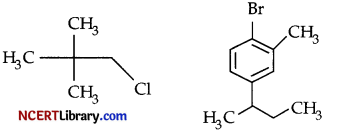
(b) Complete the reaction:

Answer:
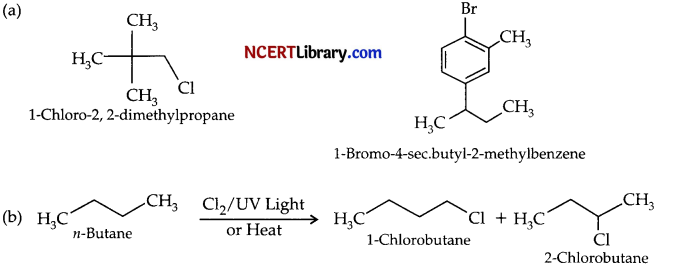
Question 22.
(a) What is the reason for high melting point of transition metals?
(b) Give a reason for favoured formation of Ce4+ although the common oxidation states of lanthanoids is + 3 state.
OR
(a) Going from Sc to Zn in the first series of the transition metals, ionisation enthalpies vary from 631 kJ mol-1 to 906 kj mol-1 (with some minor exceptions). Explain.
(b) Oxidation state of nickel and iron are zero in Ni(CO)44 and Fe(CO)5. Why? [2]
Answer:
(a) The high melting point of transition metals are due to the involvement of greater number of electrons from (n – 1)d in addition to the ns electrons in the interatomic metallic bonding. Thus, the large number of electrons participate forming large number of metallic bonds.
(b) The electronic configuration of Ce is [Xe] 4f1 5d1 6s2. Lanthanides are very less electronegative. Their electronegative value is nearly equal to s-block elements. So they can lose electrons to form a cation. When Cerium loses 4 e-, and it will acquire fully field electronic configuration of Xenon (2, 8, 18, 18, 8). As fully filed or half filed electronic configuration possesses extra stability, therefore, formation of Ce4+ is favoured.
OR
(a) Going from Sc to Zn (left to right) in the first series of the transition metals, ionisation enthalpies increases, this is due to an increase in nuclear charge which accompanies the filling of the inner d-orbitals, electrons are better bound to nucleus and there is an increase in ionisation enthalpy along each series of the transition elements from left to right.
(b) Low oxidation states are found when a complex compound has ligands capable of p-acceptor character in addition to σ-bonding. The ligand -CO is a neutral ligand and is having π – acceptor character in addition to σ – bonding. Therefore, the metals Fe and Ni show zero oxidation states.
Question 23.
Answer the following:
(a) What is Fehling’s solution?
(b) To what oxidation state ethanal converts Fehling’s solution. [2]
Answer:
(a) Fehling’s solution is alkaline solution of CuSO4 along with some Rochelle salt.
(b) Ethanal converts Cu(II) of Fehling’s solution to Cu(I) i.e., + 1 state.
Question 24.
What are the factors on which conductivity of an electrolyte depend? [2]
Answer:
The conductivity of an electrolyte depends upon:
- The nature of electrolyte
- Size of the ions produced
- Nature of solvent and its viscosity.
- Concentration of electrolyte.
- Temperature
Question 25.
(a) Which pyrimidine base is present in RNA?
(b) Name the purines present in DNA.
(c) What are nucleotides?
OR
Give the following reactions:
(a) Reaction of glucose with HI.
(b) Reaction of glucose with acetic anhydride. [2]
Answer:
(a) Uracil is the pyrimidine base present in RNA.
(b) Ademine and guanine.
(c) Nucleotide is a unit which consists of a phosphate group, a pentose sugar and an aromatic heterocyclic nitrogenous base.
OR
(a) Glucose on prolonged heating with the HI gives the n-hexane which has 6 carbon atoms connected with each other in the straight chain. Thus, this concludes that all the 6 carbon atoms in the glucose molecule are also connected linearly in the form of a straight chain.
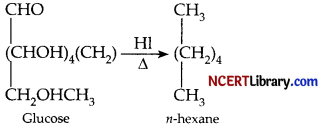
(b) Acetylation of glucose with acetic anhydride gives glucose pentaacetate which confirms the presence of five-OH groups in the structure of glucose.

Section – C
This section contains 5 questions with internal choice in two questions. The following questions are short answer type and carry 3 marks each.
Question 26.
Name two water soluble vitamins, their sources and the diseases caused due to their deficiency in diet.
OR
State clearly what are known as nucleosides and nucleotides. [3]
| Vitamin | Sources | Deficiency disease |
| 1. Vitamin B2 (Riboflavin or Lactoflavin) | Milk, yeast, green vegetables, meat, liver, kidney, egg white etc. Daily dosage is 2-3 mg. | Retards growth, causes inflamation of tongue (glossitis), dermatitis and cheilosis (cracking or fissuring) at corners of mouth and lips. |
| 2. Vitamin C (Ascorbic acid) | Citrus fruits, green leafy vegetables, chillies, sprouted pulses and germinated grains. Daily dosage is 75 gm. | Scurvy (bleeding of gums), pyorrhea (loosening and bleeding of teeth). |
OR
Nucleoside: A nucleoside contains only two basic components of nucleic acids i.e., a pentose sugar and a nitrogenous base. During their formation 1-position of the pyrimidine or 9-position of the purine moitey is linked to C1 of the sugar (ribose or deoxyribose) by a β – linkage.
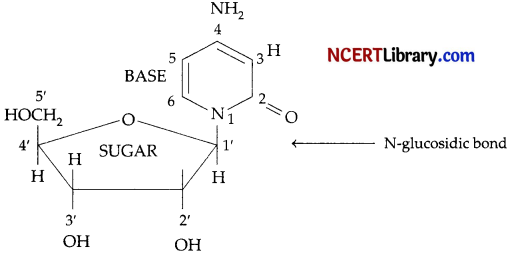
Nucleotides: A nucleotide contains all the three basic components of nucleic acids, i.e., a phosphoric acid group, a pentose sugar and nitrogenous base. These are formed by esterification of C5OH of the sugar of the nucleoside with phosphoric acid.
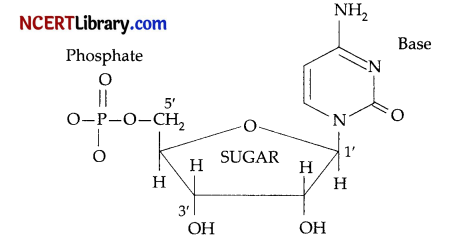
Question 27.
Write the Nemst equation. Calculate EMF of the following cell at 25°C. [3]
Pt(s) | Br2(l) | Br– (0.010 M) | H+ (0.030 M) | H2(g) (1 bar) |Pt(s)
Given:
\( \mathrm{E}_{\mathrm{Br}_2 / \mathrm{Br}^{-}}^{\circ}\) = 1. 08V
Answer:
The cell reaction is:
2Br–(aq) + 2H+(aq) → Br2(I) + H2(g)
Using Nernst equation and substituting the values.
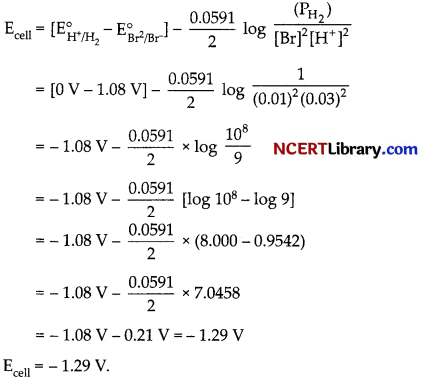
Question 28.
(a) How would you obtain acetophenone from phenol?
(b) Solubility of alcohols in water decreases with increasing size of alkyl group. why?
(c) What is Reimer-Tiemann reaction? Give equation for that. [3]
Answer:
(a) Acetophenone can be obtained from phenol by the reaction of phenol with zinc dust in the presence of heat.

(b) Solubility of alkyl or aryl group in water depends upon the following factors:
- Hydrogen bonding: Greater the extent of H-bonding, higher is the solubility.
- Size of the alkyl/aryl group: Higher the hydrocarbon part, lower is the extent of H-bonding and hence lower is the solubility. Thus, the solubility of alkyl or aryl group decreases with increase in size.
(c) Phenols react with CHCl3 and alkali to give salicylaldehyde. This Reaction is known as reimer tiemann reaction.
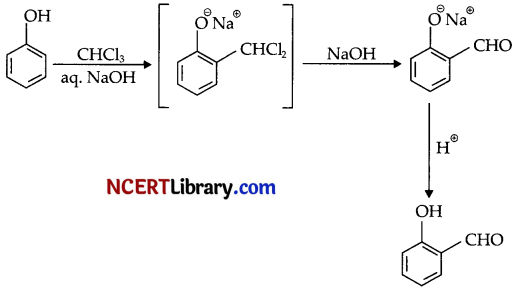
Question 29.
(a) A significant increase in the density may be noted from titanium (atomic no. 22) to copper (atomic no. 29), give reason.
(b) The transition elements form a large number of complex compounds, why? [3]
(c) Draw the structure of dichromate ion.
Answer:
(a) On moving from Ti to Cu, the atomic radii decreases due to increase in nuclear charge. The decrease in metallic radius from Ti (Z = 22) to copper (Z = 29) coupled with increase in atomic mass results in a general increase in the density of these elements..
(b) The transition elements form a large number of complex compounds due to the comparatively smaller sizes of the metal ions, their high ionic charges and the availability of d-orbitals for bond formation.
(c) The structure of dichromate ion is as follows:
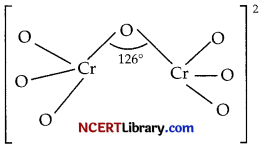
Question 30.
Give the uses of Freon 12, DDT and carbon tetrachloride. [3]
Answer:
The uses of Freon 12 and DDT are:
1. Uses of Freon-12: Freon-12 (dichlorodifluoromethane, CF2C12) is commonly known as CFC. It is used as a refrigerant in refrigerators and air conditioners. It is also used in aerosol spray propellants such as body sprays, hair sprays, etc. However, it damages the ozone layer. Hence, its manufacture was banned in the United States and many other countries in 1994.
2. Uses of DDT: DDT (p, p-dichlorodiphenyltrichloroethane) is one of the best known insecticides. It is very effective against mosquitoes and lice. But due to its harmful effects, it was banned in the United States in 1973.
3. Uses of carbon tetrachloride (CCl4):
- It is used for manufacturing refrigerants and as fire extinguisher by the name pyrene.
- It is used as feedstock in the synthesis of chlorofluorocarbons and other chemicals.
- It is used as a solvent in the manufacture of pharmaceutical products. It is a very good solvent for oils, fats and resins.
Section – D
The following questions are case-based questions. Each question has an internal choice and carries 4 (1 + 1 + 2) marks each. Read the passage carefully and answer the questions that follow.
Question 31.
Any substituent which can increase stability of conjugate base of carboxylic acid i.e., carboxylate ion will increase its acidity and a substituent decreasing the stability of carboxylate ion will decrease the acidity of carboxylic acid. It means electron withdrawing group will increase and electron donating group will decrease the acidity of carboxylic acid.
Carboxylic acids are more acidic than phenols as carboxylate ion is stabilized by two equivalent resonating structures in which negative charge is at the more electronegative oxygen atom. In comparison although phenoxide ion is also resonance stabilized but resonating structures and are non-equivalent in which negative charge is at less electronegative carbon atom, hence resonating structures of phenoxide are less important than that of carboxylate ions.
| Compound | HCl | CF3COOH | C6H5COOH | CH3COOH | C6H5OH | C2H5OH |
| pKa | -7 | 0.23 | 4.19 | 4.76 | 10 | 16 |
Answer the following questions:
(a) Arrange the acidity order of the following carboxylic acids:

(b) Why formic acid is more acidic than acetic acid?
(c) Explain the acidity order of the following acids:
(i) FCH2COOH > ClCH2COOH > BrCH2COOH > ICH2COOH
(ii) HC ≡ C-COOH > CH2 = CH-COOH > CH3COOH
OR
Why vinyl or allyl carboxylic acids are highly acidic? [3]
Answer:
(a) With the increase in the number of halogen atoms the strength of acid also increases. Hence, the acidity order will be as follows:

(b) Formic acid is more acidic than acetic acid because of the following reasons:
- +I -effect of -CH3 group distabilises the acetate ion (CH3COO–)
- Due to the small size of formate ion, it can be easily solvated.
(c) 1. Greater the electron with drawing power of halogen atom, stronger will be the acid.
2. With increase in the ‘s’-character of the carbon atom electronegativity will increase. Electronegativity order is – sp>sp2>sp3 hybridised carbon, ‘s’-character (50%) (33.3%) (25%) Hence, the acidity order will be as follows:
 OR
OR
Direct attachment of the groups such as phenyl or vinyl to the carboxylic acid is due to the greater electronegativity of sp2 hybridised carbon to which carboxyl carbon is attached.

Question 32.
The elevation in boiling point on addition of a non-volatile, non-electrolyte and solid solute to a solvent can be easily described graphically. The vapour pressure of the pure solvent or solution increases with increase in temperature. The variation of vapour pressure of solvent and solution at different temperature is shown in figure below: [3]
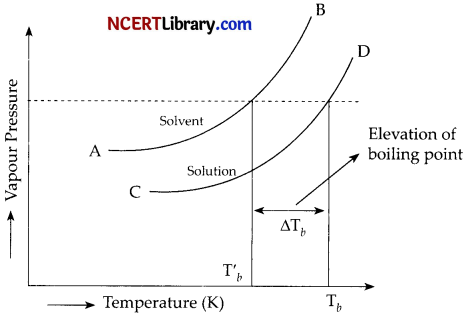
The curve AB gives the vapour pressure of the pure solvent and the curve CD gives the vapour pressure for the solution at different temperatures. The curve CD lies below the curve AB which corresponds to the vapour pressure of the pure solvent. This is due to the fact that the vapour pressure of the solution is less than that of the pure solvent at all temperatures.
Answer the following questions:
(a) Do you think that boiling point is a colligative property?
(b) Why does the use of pressure cooker reduces cooking time?
(c) Distinguish between the boiling point of a liquid and the normal boiling point of a liquid.
OR
5 g each of two solutes A and B (Molar mass of A > B) are dissolved separately in 50 g each of the same solvent. Which will show greater elevation of boiling point?
Answer:
(a) Elevation in boiling point is a colligative property but boiling point is not a colligative property.
(b) At higher pressure over the liquid, the liquid boils at higher temperature. That is why, cooking occurs faster.
(c) The boiling point is the temperature at which the vapour pressure of the liquid equals to the atmospheric pressure. The normal boiling point is the temperature at which the vapour pressure is 1 atom.
OR
Solution containing solute ‘B’ will show greater elevation in boiling point as ∆Tb ∝ \( \frac{1}{M}\)
Section – E
The following questions are long answer type and carry 5 marks each. Two questions have an internal choice.
Question 33.
The change in concentration of a reactant or product in unit time is called rate or reaction. The reaction:
2 NO(g) + O2(g) → 2 NO2(g)
was studied by the initial rate method. The following kinetic data was obtained.
| Experiment | Initial [NO]/mol L-1 | Initial [O2]/mol L-1 | Initial rate of formation of NO2/mol L-1 s-1 |
| 1. | 0.30 | 0.30 | 0.096 |
| 2. | 0.60 | 0.30 | 0.384 |
| 3. | 0.30 | 0.60 | 0.192 |
| 4. | 0.60 | 0.60 | 0.768 |
(a) What do you understand by rate law?
(b) What is the order of the reaction with respect to NO and O2?
(c) Determine the rate law for the reaction.
(d) Calculate the rate constant for the reaction.
(e) Find out the rate of formation of NO2 when [NO] is 0.1 and [O2] is 0.2 mol L-1. [5]
OR
(a) Distinguish between order and molecularity of a reaction.
(b) The decomposition of phosphine PH3, proceeds according to the following equation:
4PH3 (g) → P4(g) + 6 H2(g)
Its found that the reaction follows the following rate equation:
Rate = k[PH3]
The half life period of PH3 is 37.9s at 120°C.
(i) How much time is required for 3/4th of the PH3 to decompose?
(ii) What fraction of the original sample of PH3 remains behind after 1 minute?
Answer:
(a) Rate law is an experimentally determined expression which relates the rate of reaction with concentration of the reactants.
(b) Suppose the order of reaction w.r.t. NO is x and w.r.t. O2, it is y, then,
Rate = k [NO]x [O2]y
0.096 = k (0.30)x (0.30)y …(i)
0.384 = k (0.60)x (0.30)y …(ii)
0.192 = k (0.30)x (0.60)y …(iii)
0.768 – k (0.60)x (0.60)y ..(iv)
Dividing equation (ii) by (i), we get
\( \frac{0.384}{0.096} \) = \( \frac{k(0.60)^x(0.30)^y}{k(0.30)^x(0.30)^y}\)
4 = 2x or 22 = 2x or x = 2
Dividing (iv) by (ii), we get
\( \frac{0.768}{0.384}\) = \(\frac{k(0.60)^x(0.60)^y}{k(0.60)^x(0.30)^y}\)
4 = 2y or y = 1
Hence, order of reaction w.r.t. NO = 2
order of reaction w.r.t. O2 = 1
Rate = k [NO]2 [O2]1
Rate = k [NO]2 [O2]1
0.096 = k (0.30)2 (0.30)1
k = \(\frac{0.096}{0.09 \times 0.30} \) = 3. 55 mol-2 L2 s-1
OR
Answer:
(a)
| Order | Molecularity |
| 1. It is the sum of the power of the reacting species involved in rate law equation. | It is the number of reacting species involved in the elementary single step reaction. |
| 2. Order of reaction is determined experimentally. | It is derived from mechanism of the reaction. |
| 3. It depends upon the pressure and temperature. | It is independent of pressure and temperature. |
| 4. Order of a reaction can be zero or even fractional in some cases. | Molecularity of a reaction cannot be zero and is always a whole number. |
| 5. Order of a complex reaction is determined from its slowest step. | Multiple steps have their own melecularity in a complex reaction. There is no overall molecularity. |
(b) (i) As we can see from the rate equation that its a first order reaction. Initial concentration, let be = a
Then concentration after time, t = \( \frac{3}{4}\)a = x
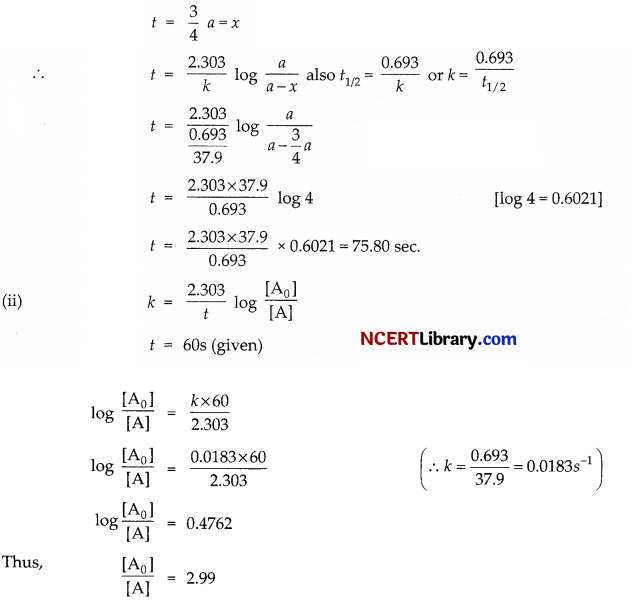
Question 34.
Account for the following:
(a) [Cr(NH3)6]3+ is a paramagnetic while [Ni(CN)4]2-– is diamagnetic. Explain why?
(b) [NiCl4]2- is paramagnetic while [Ni(CO)4] is diamagnetic though both are tetrahedral.
(c) [Fe(H2O)6]3+ is strongly paramagnetic whereas [Fe(CN)6]3- is weakly paramagnetic. [5]
Answer:
(a) Cr is in the +3 oxidation state i.e., d3 configuration. Also NH3 is a weak field ligand that does not cause the pairing of the electrons in the 3d-orbital.

Therefore, it undergoes d2sp3 hybridization and the electrons in the 3d orbitals remain unpaired. Hence, it is paramagnetic in nature because of 3 unpaired electrons.
In [Ni(CH)42]-2, Ni exists in the +2 oxidation state i.e., d8 configuration.

CN– is a strong field ligand. It causes the pairing of the 3d-orbital electrons. Then, Ni2+ undergoes dsp2 hybridization, square planar geometry and diamagnetic as no unpaired electron.
(b) Though both [NiCl4]2- and [Ni(CO)4] are tetrahedral, their magnetic characters are different. This is due to a difference in the nature of ligands. Cl– is a weak field ligand and it does not cause the pairing of unpaired 3d electrons. Hence, [NiCl4]3- is paramagnetic.

In Ni(CO)4, Ni is in the zero oxidation state i.e., it has a configuration of 3d84s2

But CO is a strong field ligand. Therefore, it causes the pairing of unpaired 3d electrons. Also, it causes the 4s electrons to shift to the 3d-orbital, thereby giving rise to sp3 hybridization. Since no unpaired electrons are present in this case, [Ni(CO)4] is diamagnetic.
(c) In. both [Fe(H2O6]3+ and [Fe(CN)6]3-. Fe exists in the +3 oxidation state i.e., in d5 configuration.

Since CN– is a strong field ligand, it causes the pairing of unpaired electrons. Therefore, there is only one unpaired electron left in the d-orbital.

Therefore,
µ = \(\sqrt{n(n+2)}\)
= \(\sqrt{1(1+2)}\) = 3 = 1.732 BM
On the other hand, HzO is a weak field ligand. Therefore, it cannot cause the pairing of electrons. This means that the number of unpaired electrons is 5.
Therefore,
µ = \(\sqrt{n(n+2)}\)
= \(\sqrt{5(5+2)}\) = 5.916 BM
Hence, [Fe(H2O6]3+ is strongly paramagnetic, while [Fe(CN)6]3-“ is weakly paramagnetic.
OR
(a) What is crystal field splitting energy? How does the magnitude of D0 decide the actual configuration of d-orbitals in a coordination entity?
(b) Discuss briefly giving an example in each case the role of coordination compounds in:
(i) Biological system
(ii) Medicinal chemistry
(iii) Analytical chemistry
(iv) Extraction or metallurgy of metals
Answer:
(a) The degenerate d-orbitals (in a spherical field environment) split into two levels i.e., e8 and t2g in the presence of ligands. The spliting of the degenerate levels due to the presence of ligands is called the crystal-field splitting while the energy difference between the two levels [eg (high) and t2g (low)] is called the crystal-field splitting energy. It is denoted by ∆0 for octahedral complexes.
After the orbitals have split, the filling of the electrons taks place. According to Hund’s rule 1 electron is been filled in the three \(t_{2 g_1}\) orbitals, the filling of the fourth electron takes place in two ways. It can enter the eg orbital (giving rise to \(t_{2 g}{ }^3 e_{g_0}^1\) like electronic configuration) or the pairing of the electrons can take place in the t2g orbitals (giving rise to \(t_{2 g_1}{ }^4 e_{g_0}\) like electronic configuration).
If the ∆0 value of a ligand is less than the pairing energy (P) (∆0 < p) then the electrons enter the e8 orbital. On the other hand, if the ∆0 value of a ligand is more than the pairing energy (P) ( ∆0 < p) then the electrons enter the t2g orbital. Thus, the value of ∆0 decides the configuration and magnetic matrix of the complex.
(b) (i) Role of coordination compounds in biological system: Photosynthesis is made possible by the presence of the chlorophyll pigment. This pigment is a coordination compound of magnesium. In the human biological system, several coordination compounds play an important role. For example, the oxygen-carrier of blood, i.e., haemoglobin, is a coordination compound of iron. Enzymes sometimes use Chelation to perform biological catalytic reactions.
(ii) Role of coordination compounds in medicinal chemistry: Certain coordination compounds of platinum (for example, cis-platin) are used for inhibiting the growth of humours. Specially the cis-isomer. Now a days it is replaced by dinuclear platinum complex because of certain side effects.
(iii) Role of coordination compounds in analytical chemistry: During salt analysis, a number of basic radicals are detected with the help of the colour changes they exhibit with different reagents. These colour changes are a result of the coordination compounds or complexes that the basic radicals form with different ligands, e.g., Cu2+ ion detection where deep blue and chocolate colour ppt. are produced where both are complex compounds.
(iv) Role of coordination compounds in extraction or metallurgy of metals: The process of extraction of some of the metals from their ores involves the formation of complexes. For examples, in aqueous solution, gold combines with cyanide ions to form [Au(CN)2]. From this solution, gold is later extracted by the addition of zinc metal. Also silver ore can be extracted using same method.
![]()
Question 35.
Account for the following:
(a) pKb of aniline is more than that of methylamine.
(b) Ethylamine is soluble in water whereas aniline is not.
(c) Methylamine in water reacts with ferric chloride to precipitate hydrated ferric oxide.
(d) Although amino group is o, p-directing in aromatic electrophilic substitution reactions, aniline on nitration gives a substantial amount of m-nitroaniline.
(e) Aniline does not undergo Friedel-Craft’s reaction. [5]
Answer:
(a) pKb of aniline is more than that of methylamine: Higher the pKb value lower is the basic strength.
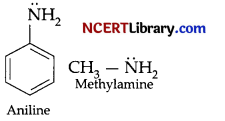
In Aniline due to resonance, the electrons on the N-atom are delocalised over the benzene ring. Therefore, the electrons on the N-atom are less available to donate.

On the other hand, in case of methylamine (due to the + I effect of methyl group), the electron density on the N-atom is increased. As a result, aniline is less basic than methylamine. Thus, pKb of aniline is more than that of methylamine.
(b) Ethylamine is soluble in water whereas aniline is not: Ethylamine when added to water forms intermolecular H-bonds with water. Hence, it is soluble in water.
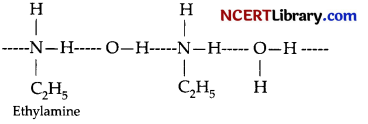
But aniline does not undergo H-bonding with water to a very large extent due to the presence of a bulky hydrophobic – C6 H5 group. Hence, aniline is insoluble in water.

(C) Methylamine in water reacts with ferric chloride to precipitate hydrated ferric oxide: Methylamine is more basic than water. Therefore, in water, methylamine produces OH– ions by acepting H+ ions from water.
CH3 – NH2 + H – OH → CH3 – +NH3 + OH–
Then, OH– ion reacts with Fe3+ ion, from dissociated FeCl3 to form a precipitate of hydrated ferric oxide.

(d) Although amino group is o, p-directing in aromatic electrophilic substitution reactions, aniline on nitration gives a substantial amount of m-nitoraniline: Nitration is carried out in an acidic medium. In an acidic medium, aniline is protonated to give anilinium ion (which is meta-directing).

For this reason, aniline on nitration gives a substantial amount of m-nitroaniline.
(e) Aniline does not undergo Friedel-Craft’s reaction: A Friedel-Craft’s reaction is carried out in the presence of AlCl3 but AlCl3 is a Lewis acid while aniline is a strong base. Thus, aniline reacts with AlCl3 to form a salt

Due to the positive charge on the N-atom, electrophilic substitution in the benzene ring is deactivated. Hence, aniline does not undergo the Friedel-Craft’s reaction.